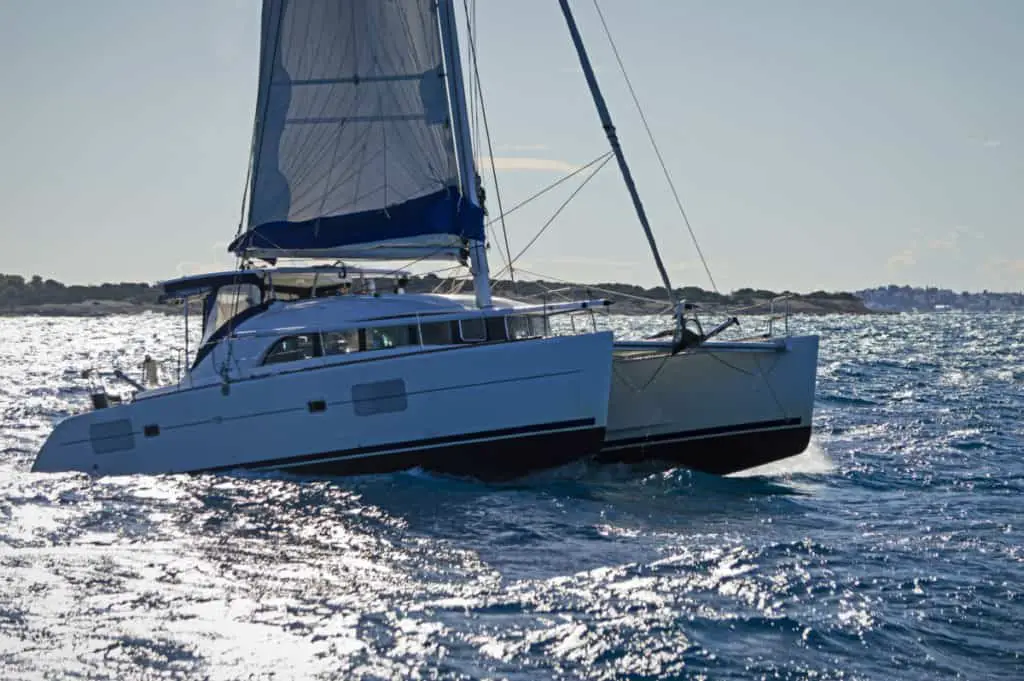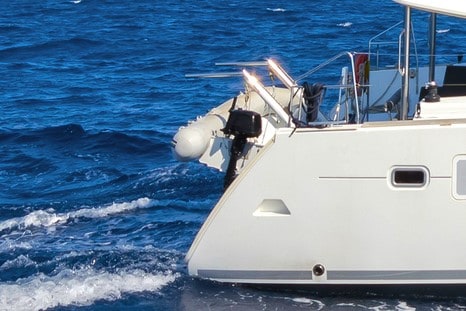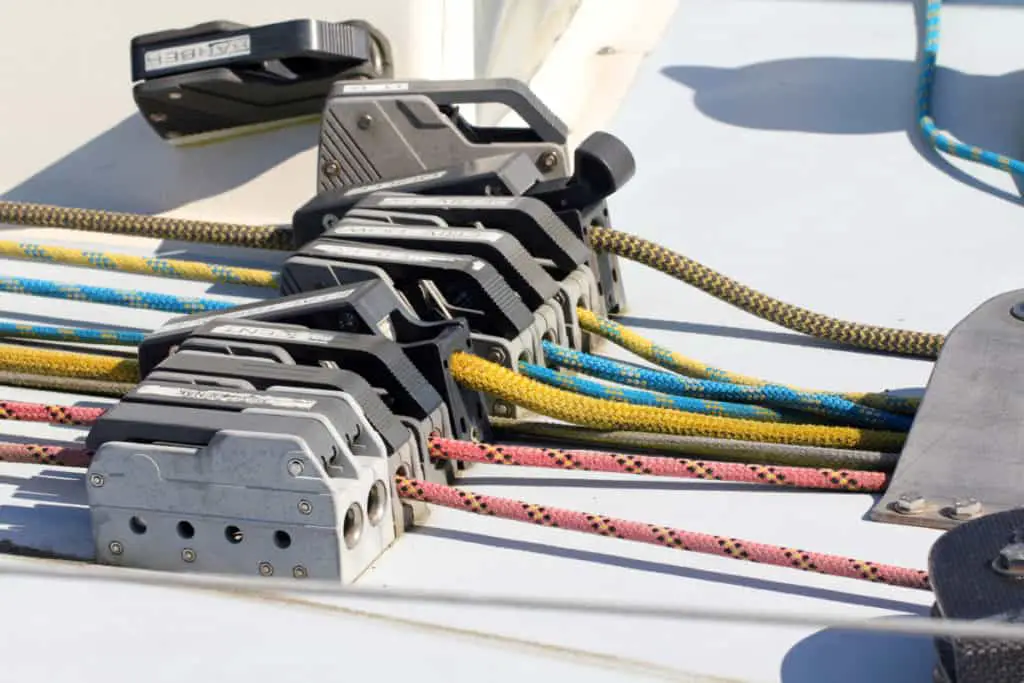As an Amazon Associate, we earn from qualifying purchases. We may also earn commissions if you purchase products from other retailers after clicking on a link from our site.
Crossing the Pacific ocean is a challenging but exhilarating experience for any sailor, it is a must-do for circumnavigators and the path between the Americas and Australia. The Pacific Ocean can be rough at times and therefore it’s worth discussing whether or not a catamaran is suitable for this journey!
A Catamaran is an excellent vessel for crossing the Pacific Ocean. Catamarans make suitable vessels for long sea journeys as they are spacious, stable, and move at high speeds. Their stability makes them resist capsizing, the high speeds allow for outrunning storms and the interior space allows for enough crew and food.
In this article, I will go over the advantages of sailing across the Pacific on a catamaran. I will also discuss the potential length of time your voyage would take, the risks associated with cruising this area, and whether it’s feasible to do it alone.
Can a Catamaran Cross the Pacific Ocean?
Catamarans are ideal for crossing the Pacific. The vessels are an ideal choice for any long journey, even crossing the Pacific, thanks to their size, large living area, high stability, and high speeds. The boat’s length, which should be at least 30 feet (9.1 m) long, is a significant consideration.
Crossing the ocean is no easy feat, even for the most experienced sailors. The good news is that a catamaran of a decent size, that is, above 35ft long, can handle the long journey.
You can make this journey on a 35 feet boat but preferably it should be done with something bigger than 40 feet.
If you want to better understand why catamaran size matters I suggest you check out my other article named best sized and catamaran for ocean sailing.
However, when considering crossing the ocean, you must be well-prepared for all the obstacles you might run into. Having an experienced crew on board is vital to a successful journey.
Prepare Well for Your Pacific Ocean Crossing
A lot goes into preparing for such a long journey. Planning ahead and doing research is necessary to ensure that you are ready for your trip across the ocean. If you have experienced sailor friends, you can always ask them to provide any tips they might have. There are also numerous helpful resources online that can aid you in getting prepared for crossing the Pacific.
When it comes to sailing across the ocean, you must be sure of your skillset as a sailor. Also, it would be quite helpful if you have a group of equally experienced sailors to help you along your journey.
When you prepare well and take all precautions necessary, crossing the Pacific Ocean will be an exhilarating experience and one that you will remember for a lifetime.
Choose the Right Vessel

Choosing the right vessel for your journey is the first step in preparing for the journey. There are many great options to choose from, and a sailing catamaran is among the best choices. Many experienced sailors prefer sailing with a modern catamaran over other boats because of its comfort, stability, and high speed.
Space
Larger catamarans have enough space to have a comfortable sail while not sacrificing performance. They are especially suitable for families that like to travel together. Large living spaces also provide excellent privacy if needed. This also allows enough room for a kitchen, making the cooking experience onboard more enjoyable.
With 40+ ft catamarans, there is enough space to fit several passengers and crew members.
More on catamaran size here.
Stability
Thanks to the dual hull design, catamarans are also much more stable than their monohull counterparts. This reduces the movement of the boat from waves and makes seasickness less likely, thus decreasing the risk of crew fatigue and sailor mistake.
More on why catamarans capsize.
High Speed
The low drag of catamarans develops higher speeds, cutting down the time needed to reach your next destination. It will also increase the likelihood of running away from a storm or avoiding a squall. A faster boat, if only if you are not faster, will in the long run get you to your destination days ahead of time.
This can be the difference between sailing in horrible conditions or cruising into harbor on a sunny beautiful day.
Here’s a video of a passage between New Zealand and French Polynesia.
How Long Does It Take To Cross the Pacific on a Catamaran?
Crossing the Pacific on a catamaran takes between two weeks to more than a month, depending on a variety of factors. The beginning and ending points, the number of stops you make, wind and weather conditions, and the size and speed of your boat all contribute to the length of your journey.
There are numerous ways you can go about sailing across the Pacific. Depending on your starting point and destination, there are also several popular and widely-used routes available.
Every journey requires careful planning, and your Pacific journey will be no different. However, you have to be ready for some adjustments to your plans as you can’t predict everything that might happen on your journey.
Crossing The Pacific During The “Sailing Season”
There are certain times of the year when sailing across the Pacific is safest, such as during the so-called sailing season, or dry season.
This sailing season runs from May to October, when there is less chance of rain and cyclones.
When embarking on a journey across the Pacific Ocean, many people choose one of the following drop-off points: If you live on the West Coast of the United States, you can begin your journey near Seattle, at the US-Canada border of the Juan de Fuca Strait.
If you want to start in the south, go to Mexico, specifically Cabo San Lucas. The Panama Canal is the only way to get to the Pacific from the East Coast.
Plan Your Route Well
Whatever route and time of year you choose, the most important part of your preparation for the journey will be carefully planning your route. With the aid of modern technology, you can easily map out your ideal route, complete with stops at numerous islands scattered across the ocean. This will make your journey both interesting and enjoyable.
While you can estimate how long the journey will take, there is no way to predict precisely how much time you will spend crossing the Pacific. This is because there are far too many variables to consider when determining how long the trip will take. That’s why it is critical to keep an open mind, enjoy your journey, and not worry about exactly how long it will take you.
How Dangerous Is It To Sail Across the Pacific?
Sailing across the Pacific is one of the safer large ocean crossings you can do. Although, longer journeys come with a number of risks, including bad weather, accidents onboard, or worsening of any existing health issues. Most of these, though, may be mitigated with careful planning.
Every action we engage in has some level of danger associated with it. Some activities involve higher risks than others. Sailing over an ocean is a dangerous task, and many things can go wrong during your voyage. On the other hand, sailors are well aware of the level of risk they are taking on when venturing out onto the open seas.
Risks Associated With Sailing Across the Pacific
Most of the risks associated with sailing across the Pacific can be successfully overcome with proper expertise and thorough preparation.
Some factors, such as weather, are beyond your control; nevertheless, picking the appropriate time of year for your journey might help mitigate such dangers.
When traveling by car, navigating in bad weather conditions can be challenging. The risks that come with unfavorable weather conditions are increased exponentially at sea. Storms cause not just rain and wind but also waves and rough water conditions.
Is the Pacific or the Atlantic more dangerous ? Find out here!
Health Issues
Another issue that you might encounter during your trip is related to any health issues or injuries of the crew or passengers on board. Most people are aware of their health-related concerns and are ready to manage them when sailing. However, health conditions can not always be predicted.
Numerous studies have been undertaken over the years concerning health issues that sailors may experience when living aboard the boat for extended periods of time.
The tight space on the boat, lack of exercise, poor nutrition, temperature fluctuations, and isolation from the outside world are all factors that put sailors at risk of developing numerous illnesses. According to one study, sailors on board are at a greater risk of dying from a myocardial infarction.
Risk of Injury
The risk of injuries is also high aboard. There are numerous tools and gear on a boat that could potentially be hazardous, especially for those who are not used to handling them. Additional factors that often cause injuries are related to sun exposure and lacerations from sharp objects.
No matter the weather or time of year, when you spend time in the open sea, your skin gets overly exposed to the sun and can get easily burnt or damaged. When spending a lot of time at sea, using sunscreen with a high Sun Protection Factor (SPF) is necessary to protect your skin from potential sun damage.
It’s a must to have a first aid medical kit on board in case of any injuries or illnesses that may happen to you or others on your boat. Additionally, knowledge about resuscitation and how to provide immediate medical assistance are essential skills to have for at least one of the people on board, if not for all.
Man Over Board (MOB) and Solo Sailing

Drowning is another potential concern when sailing across the ocean. It is fairly easy for a passenger or sailor to slip overboard by accident.
Current technologies and safety procedures make it possible (but incredibly hard usually) to quickly assist the individual and get them back on board.
However, there is still a substantial risk if the overboard mishap occurs in rough seas or at night. In most situations, however, drowning may be avoided by taking proper precautions.
When it comes to single-handed sailing, the dangers of drowning in the event of an overboard accident are substantially greater, as I will explain further below. Otherwise, drowning can be caused by other circumstances, such as injuries, boating accidents, or underlying health conditions that might render someone unconscious and cause them to fall overboard.
Ultimately, there’s nothing particularly worrisome about the Pacific ocean that cannot be applied to any other open seas. As such, if all safety precautions are taken before you set off on your journey, most of the associated risks can be easily mitigated.
Can You Sail Across the Pacific Alone (Shorthanded)?
While you can sail solo across the Pacific, taking such a long journey alone can be dangerous. For instance, you may undergo psychological and physical health issues, which a lack of sleep could exacerbate. And in case of an accident, the chance of death is also significantly higher.
Any seasoned sailor would advise against embarking on such a long solo boat trip without extensive experience. There are numerous reasons why sailing alone across the Pacific is not a good idea for everyone. The crossing includes both external challenges posed by the ocean and the psychological stress that you will experience.
Nothing can truly prepare you for what the open ocean has in store for you, even if you have years of experience taking short solo sailing trips.
However, the fact that many people strongly discourage solo ocean crossings does not mean that some sailors have not succeeded in such endeavors. This is an adventure of a lifetime!
The Hazards of Solo Ocean Crossing

There are many hazards associated with sailing across the Pacific Ocean alone. These include:
Falling Overboard
Marine technologies have advanced significantly in recent years, allowing boats to be equipped with various devices that are aimed at preventing accidents. However, the risk is still quite high; in case you fall overboard and your catamaran is set on autopilot, there’s not much you can do to save yourself.
Most offshore boats are equipped with a tethering system that attaches the sailor to the boat with a rope, this means that in case the sailor falls overboard he or she will still be attached to the boat. This is not a good situation, but it’s way better than the boat sailing away from you.
Insomnia
Another challenge you’ll encounter when taking such a long solo journey will be a lack of sleep. Catamarans, as well as other types of boats, require great attention to make sure they are operating correctly and that you’re headed the right way whilst avoiding traffic. Therefore, you won’t be getting enough sleep as you work to ensure that everything on board is in order.
When sailing, at least one person should always be alert to see any potential hazards in advance. With single-handed sailing, this becomes impossible. There are many guides on how a person can survive with little sleep, such as taking short naps often, but doing that for days on end can be taxing for the body.
With the lack of sleep comes numerous complications even under normal circumstances. Considering that you’ll be all alone on the high seas adds another challenging aspect. With lack of sleep, your stress levels will rise, and you might lose focus along with lack of energy, eventually leading you to a potential disaster.
Potential Safety Risk
While single-handed sailing over a long distance, you are not only being a danger to yourself but also putting other sailors at risk. While modern technology has allowed boats to detect any ships coming their way, the risk of collision still remains if the solo sailor is sleeping or otherwise preoccupied.
Also, not all boats will be detected by this type of warning system, or AIS (automatic identification system) as it is called.
Final Thoughts
To sum up, it’s quite possible to cross the Pacific ocean on a Catamaran. However, sailing alone on such a long journey is tough even for the most experienced sailors.
Here are Some of My Favorite Catamaran Cruising Resources
Thank you for reading this article. I hope you found it helpful as you hopefully start your sailing adventures. Here are some resources that I use as a sailor that I hope you’ll also find helpful. These are affiliate links, so if you do decide to use any of them, I’ll earn a commission. But in all honesty, these are the exact things that I use and recommend to everyone, even my own family.
Sailboats: If you’re looking for the best boat to suit your needs, I would recommend a catamaran. If you’re interested, I can show you the differences between catamarans and other types of sailboats.
Books: For getting started, I really like Cruising catamarans made easy. It is actually a textbook from the American sailing association; it is used to get a cruising catamaran certification. There are some other great books, and I have compiled a list of books about cruising catamarans that you will find useful.
Communication: Being out on adventures, whether it be sailing or climbing mountains, good communications are essential to being safe. I recommend two things Google fi (incredibly simple cellular data all over the world) and Garmin inreach mini (for text and voice in remote areas without cell coverage)
Sailing courses: Online sailing courses are great for beginners starting out their sailing career; it’s an efficient way of learning the basics of navigation, throttle controls, and maritime safety. I suggest starting with two free courses from NauticEd.
To see all my most up-to-date recommendations, check out this resource that I made for you!

